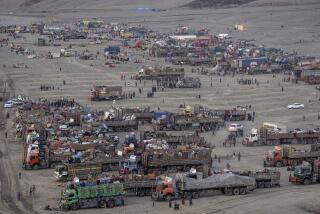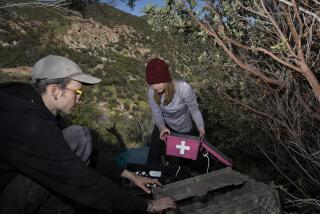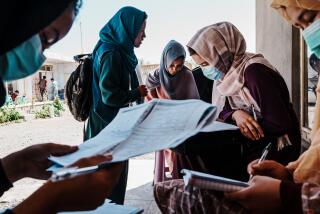Highland Soldiers Face Two Enemies
- Share via
SHAWOL, Afghanistan — In a high mountain pass that cuts through the barren Hindu Kush range, opposition fighters have another enemy to worry about beyond the Taliban soldiers just a few hundred yards down the road. The winter wind can kill too.
It blows in from the north like an icy knife, a howling gale that can dump so much snow at once that soldiers on post each night, in shifts of an hour or two, have to be careful that they aren’t buried alive.
While they wait for their spell in the deathly cold, the other eight men huddle in a stone hut about 12 feet by 6 feet. In turns, someone builds a fire outside, and when the wood is well burned, he carries the red-hot embers into the stone hut and pours them into a small pit dug in the dirt.
Then he covers the pit with a little wooden table, which radiates heat like a wood stove.
As the men encircle it, lying shoulder to shoulder under blankets, they are warmed by the dying remnants of fire and the shared heat of their own bodies. And in the glow of an oil lamp, they talk, about the news, about the weather, about their families, about the war.
Lately, they have passed many hours in the half-light imagining the city of Mazar-i-Sharif, an almost mythical place to them in the arid lowlands about 125 miles to the northwest that only one of the soldiers has ever seen, and where they all hope to be soon.
“Of course we are looking forward to seeing Mazar because it is warm there, and it isn’t in the mountains,” said Najibullah Ghulami, 32. He commands the opposition soldiers at the Shawol post next to the main road from Kabul, the capital, to Mazar-i-Sharif.
The Northern Alliance lost Mazar-i-Sharif to the Taliban in 1998, and the opposition is now fighting to retake it with the help of U.S. bombers and small groups of American soldiers acting as advisors on the ground.
Two former rivals, Gen. Abdul Rashid Dostum and Ata Mohammed, are leading a two-pronged assault on Mazar-i-Sharif. It would be an ideal bridge for resupply to the poorly armed alliance, which says it has advanced almost to the city’s southern outskirts and about 25 miles to the southwest.
Anti-Taliban forces are near the village of Cheshme Shafta, about 10 miles south of Mazar-i-Sharif, according to Gen. Abdul Basir, whose forces are poised at the top of the Salang Pass, ready to seize the main north-south highway if Mazar-i-Sharif falls.
Basir said he has already received the order from the alliance’s high command to make preparations for clearing the vital Salang tunnel of steel beams, concrete slabs and other heavy debris that have blocked both ends since 1997, when opposition troops blew them up to stop a Taliban advance.
“We would be able to clear the way to Mazar in 10 days’ time,” Basir said. “We don’t have sophisticated equipment, but I will get 200 or 500 people to clear the inside of the tunnel and both entrances with shovels. We will start work before Mazar-i-Sharif falls.”
The opposition soldiers on the front line at Shawol, northwest of the Salang tunnel, say they expect to be told to advance and take the road if the Taliban loses control of Mazar-i-Sharif.
The former Soviet Union built the 1.6-mile-long tunnel, reportedly the highest in the world at 11,034 feet, as an aid project that was officially opened in November 1964.
But Moscow had more than better trade in mind when its engineers bored deep into the mountains to link southern Afghanistan with the north, and its border with Soviet Central Asia. Long convoys of Soviet tanks and other military vehicles passed through the tunnel to occupy Afghanistan in 1979, and then in retreat a decade later.
Now the only way through the Salang tunnel is on foot. It’s a freezing half-hour hike through a pitch-black cavern, with severed electrical cables, giant air ducts and pieces of concrete and twisted steel hanging like stalactites from the ceiling.
From there, it’s a 45-minute trek through snow-covered mountains to the isolated men of Shawol, waiting for action on the road to Mazar-i-Sharif.
In peacetime, Mazar-i-Sharif wasn’t known for being strategically located, but for being the site of the Tomb of Ali, a cousin and son-in-law of the prophet Muhammad who was the fourth caliph of Islam.
On good days, visitors would gather in a huge open plaza next to the city’s beautiful blue-tiled mosque and pose for pictures among white doves that landed on their heads, shoulders and outstretched arms.
There was no more picture-taking after the Taliban stormed the city in 1998, killing between 5,000 and 8,000 civilians. The hard-line Islamic regime prohibited photographs of living beings, forced all women to cover themselves under the head-to-foot burka and enforced a long list of other edicts.
The men posted at Shawol dream of a different Mazar-i-Sharif, from the time before the Taliban, when young women could attend university, uncovered, and men gathered in kebab restaurants to ogle episodes of “Baywatch” on satellite TV.
It is a warm thought for a frigid night in the Salang Pass, where it gets cold enough to kill a man in 10 minutes if he isn’t properly wrapped, commander Ghulami said.
Last year, a soldier on night duty didn’t return to the stone hut on time after his shift was over, so a search party went out to look for him in the snow, said soldier Syed Hussain.
“He was frozen so badly that he couldn’t move his jaw, he couldn’t speak,” added Hussain, who said he was 45 but looked more like 60. “We carried him on our backs to the hospital.”
To get through the long nights, the soldiers often listen to shortwave radio broadcasts for the latest news on their war, and they have heard that some of the promised military aid from the United States includes winter wear so they can fight better in the snow.
Hussain, for one, would be glad to have the latest thermal gear. The best he has now is an old Russian army hat and a single gray woolen glove that his wife knitted for him last year.
“It doesn’t work,” he said, stuffing it back into his coat pocket.
One thing that worries the front-line soldiers more than the cold and the Taliban troops just down the road is the land mines their foes were seen laying at night just over a week ago, Ghulami said.
“They have laid land mines everywhere on their front line on the road and on the ground,” he said. “One of our guys on duty saw them doing it in the moonlight.”
The Northern Alliance troops often rely on homemade minesweepers, such as long-handled wooden rakes, because proper electronic detectors are so hard to come by. So they would sooner have the U.S. military send the best mine-clearing equipment than warm clothes.
“It is our most dire need,” Ghulami said. “But if we are ordered by the Ministry of Defense to advance toward the Taliban positions, we will have to clear the mines by shovel, by pickax or anything else we have.”
Short of an offensive, the hardest time for the soldiers in the northern Salang will come in about a week, when the next new moon marks the start of the Muslim holy month of Ramadan.
From dawn until sunset, they will not be able to eat, drink tea or smoke a cigarette. If they aren’t well on the road to Mazar-i-Sharif by then, the wait will be even harder to bear.
They have suffered worse and will no doubt suffer worse still until the fighting is finally over, said commander Del Aqa, 36, Basir’s deputy in the Salang Pass.
“War is the worst word in the world,” Aqa said. “And when you are at war, you accept all kinds of disasters.”
More to Read
Sign up for Essential California
The most important California stories and recommendations in your inbox every morning.
You may occasionally receive promotional content from the Los Angeles Times.













